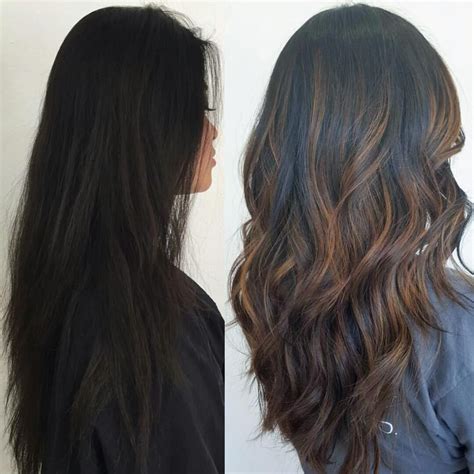When it comes to enhancing the allure of dark hair, two coveted hair coloring techniques reign supreme: balayage and highlights. While both methods aim to illuminate and add depth to the hair, they do so in distinct ways that cater to different preferences and aesthetic goals. This comprehensive guide will delve into the intricate details of balayage vs highlights on dark hair, empowering you to make an informed decision that complements your unique style.

Understanding Balayage
Balayage is a freehand painting technique that meticulously places highlights onto the hair, creating a seamless, sun-kissed effect. Unlike traditional foiling techniques, balayage allows for customizable placement and blending, resulting in a natural-looking, lived-in color that effortlessly transitions from roots to ends.
Pros of Balayage on Dark Hair:
- Natural-looking results: Balayage mimics the natural lightening effects of the sun, creating highlights that blend seamlessly with the base color.
- Low maintenance: The subtle gradient of balayage requires less frequent touch-ups compared to traditional highlights, saving time and money.
- Versatile: Balayage can be tailored to suit a wide range of preferences, from subtle dimension to bold, contrasting highlights.
Exploring Highlights
Highlights, on the other hand, involve the strategic placement of lighter hair sections using a foil or cap. This technique offers more precise control over the color and placement, creating a bolder, more defined look. Highlights can range from subtle, face-framing streaks to vibrant, full-head transformations.
Pros of Highlights on Dark Hair:
- Dramatic impact: Highlights create a striking contrast against dark hair, adding instant brightness and dimension.
- Precision: Foiling or capping allows for precise placement of highlights, ensuring the desired color and pattern are achieved.
- Flexibility: Highlights can be customized in terms of width, intensity, and placement, catering to individual preferences.
Comparison of Balayage vs Highlights
Technique:
- Balayage: Freehand painting
- Highlights: Foiling or capping
Placement:
- Balayage: Seamless, blended
- Highlights: More defined, precise
Effect:
- Balayage: Natural-looking, subtle
- Highlights: Dramatic, contrasting
Maintenance:
- Balayage: Low maintenance
- Highlights: Medium to high maintenance
Choosing the Right Technique for You
The ideal choice between balayage and highlights depends on your desired outcome. If you seek a natural, sun-kissed look with minimal upkeep, balayage is an excellent option. Conversely, if you prefer a more defined, high-impact transformation, highlights may be a better fit.
Step-by-Step Approach to Balayage and Highlights
Balayage:
- Section hair into small pieces.
- Hold a tint brush or palette knife perpendicular to the hair shaft.
- Apply bleach or hair color directly onto the brush or palette knife.
- Freehand paint the color onto the hair, focusing on the mid-lengths and ends.
- Allow the color to process until the desired lightness is achieved.
Highlights:
- Divide hair into sections.
- Create thin, vertical sections of hair.
- Place a foiling or cap under each section of hair.
- Apply bleach or hair color to each section and fold the foil or cap over it.
- Allow the color to process according to the manufacturer’s instructions.
Effective Strategies
For Balayage:
- Use a mix of light and dark colors to create depth and dimension.
- Paint the color in thin, staggered strokes to achieve a natural-looking effect.
- Allow the color to process for a longer duration on the ends to create a more prominent ombre effect.
For Highlights:
- Use a fine-toothed comb to create precise sections of hair.
- Place the foils or cap tightly against the hair to prevent color leakage.
- Leave a few millimeters of dark hair around the hairline to avoid a harsh contrast.
Pros and Cons Table
| Feature | Balayage | Highlights |
|---|---|---|
| Appearance | Natural-looking, subtle | Dramatic, contrasting |
| Maintenance | Low | Medium to high |
| Technique | Freehand painting | Foiling or capping |
| Versatility | Highly customizable | Customizable |
| Cost | Typically higher than highlights | Typically lower than balayage |
Cost Considerations
The cost of balayage and highlights varies depending on factors such as hair length, desired color change, and salon location. Generally, balayage tends to be more expensive than highlights due to its more time-consuming and artistic nature.
Frequently Asked Questions
Q: Which technique is better for dark brown hair?
A: Both balayage and highlights can be flattering on dark brown hair, depending on the desired effect.
Q: Can I do balayage or highlights at home?
A: While it is possible to DIY these techniques, it is highly recommended to seek professional help for optimal results and to avoid any potential hair damage.
Q: How often should I touch up my balayage or highlights?
A: The frequency of touch-ups depends on the specific technique and the rate of hair growth. Generally, balayage requires less frequent touch-ups (every 12-16 weeks) compared to highlights (every 8-12 weeks).
Conclusion
Whether you opt for the natural allure of balayage or the bolder impact of highlights, both techniques can transform dark hair into a vibrant and captivating masterpiece. By carefully considering your preferences, lifestyle, and hair type, you can make an informed decision that aligns with your desired aesthetic and complements your unique style. Embark on this hair coloring adventure with confidence, knowing that you are equipped with the knowledge to elevate the beauty of your dark locks.
